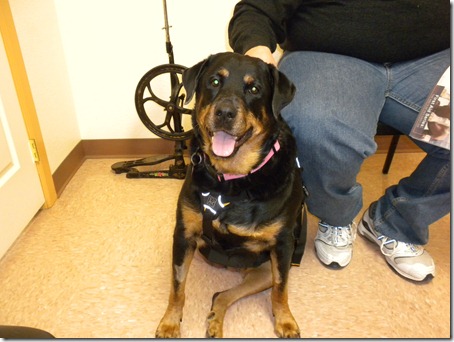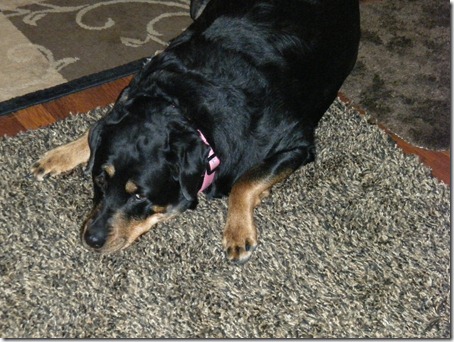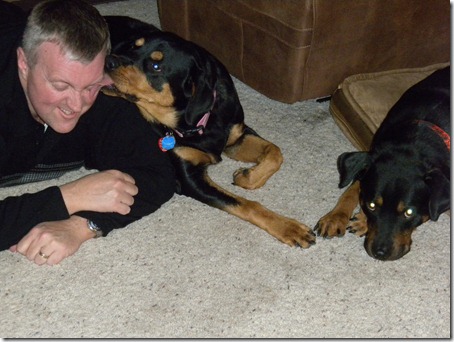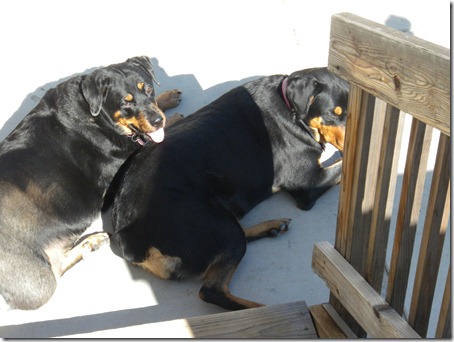Nikki just continues to improve post surgery. She’s getting around just fine, and is starting to act like the old Nikki in just about every way.
I had to take off early this morning and head into the office for a series of meetings, then race back home in time to get Nikki to her appointment with Dr. Friedly. Before I left this morning, we (All of the dogs and I) went through what I would have to say is the first “totally normal” morning routine since Nikki’s surgery. (The routine is pretty simple, I get up and head downstairs, the dogs follow, they go outside and do their business, then come back in and wait for me to start handing out the treats. Usually this involves 3 dogs scrambling for position in front of the pantry door. This morning we had all 3 in the mix and Nikki was very pleased to get a normal treat.
We had our appointment with Dr. Friedly early this afternoon. The idea behind the appointment was to discuss Nikki’s case up to this point, and get an idea of what our options are in terms of a treatment program. We also wanted to learn a bit more about Dr. Friedly and understand what his approach to this kind of treatment is. (Here’s a picture of Nikki waiting for Dr. Friedly to come in)

Dr. Friedly has over 30 years of experience as a Veterinarian. He has many impressive diplomas and certificates on his walls from places like Washington State University and Colorado State University (Did you know that there was a diploma that certifies a veterinarian as an acupuncturist?). He has spent many years treating animals, and has dedicated the last 10 to an entirely natural and holistic practice. He explained to us that he’s seen many, many cases like ours, both as a conventional western doc, and as a holistic/homeopathic practitioner as well. He was pretty clear with us that there’s no magic bullet in treating cancer, and that ultimately the end-result is going to be the same whether we go down a natural path or a conventional one. The difference though is in quality of life, and he’s seen enough cases where that average 4 month lifespan has increased into years, even with aggressive cancers like osteosarcoma.
It seems that the key to controlling this is preventing the cancer from “attaching” when it spreads. Basically when the cancer metastasizes it’s looking for a hospitable place to go. For Osteosarcoma, the lungs tend to be the most hospitable environment aside from the bone.
Dr. Friedly has seen the most success with a regimen that includes:
- Artemisia Annua (Artemenisin/ Artecin) – This is actually more commonly known as “Sweet Wormwood”. There have been studies that show Artemenisin kills cancer cells in the petri dish, but there’s not a lot of evidence to show it working once it’s “inside” the dog. However there is enough anecdotal evidence to say that it does help slow the growth of the cancer cells that it’s worth using. The science behind this is that cancer cells like to attach to iron molecules. The Artemisia interferes with this process and causes the cancer to “move on” in the bloodstream where it can get cleaned out by natural processes without ever getting the chance to adhere to anything.
- Pectin – (I had a real hard time with this one, I know pectin as a thing that you use in canning) Apparently pectin (both from Apples and Citrus) has some properties that help the body build up resistance to the cancer cells that helps discourage them from attaching anywhere.
- Phytoprofen – This is a combination of Tumeric, Indian Frankincense, Bromelain and Ginger. Basically it’s an anti-inflammatory that also helps strengthen cell walls.
The interesting thing about this whole process for me is that I’m an engineer, so things that are natural/homeopathic are by definition foreign to me. Dr. Friedly took great pains to explain the science behind each of these things, and of course it all sounds good at this point.
So, starting today, Nikki is going to be using the regimen above, in conjunction with regular visits to see Dr. Pyne for the “normal” follow-up.
If you are considering the natural approach to the post-amputation care for osteosarcoma, there’s a couple of things that I would really recommend you do. First, don’t believe everything you read. Find someone who truly has experience with treating animals with cancer, and find someone who isn’t trying to profit from your hopes. Secondly, understand the effects of the herbs that you’re using. One very important part of our treatment plan is the fact that since Artecin changes the way the body reacts to iron, you don’t want to have it in their system at the same time any meat product is (Meat is full of Iron). You need to wait 2 hours after feeding any meat product before giving Artecin and visa-versa. You also want to speed the absorption of the Artecin by wrapping it in cheese or some other non-meat fat…
I really enjoyed our time with Dr. Friedly. I think he is going to be a great advocate for Nikki on this journey.






 Posted by Ted
Posted by Ted
